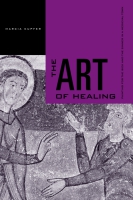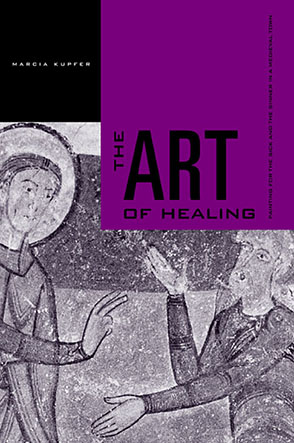The Art of Healing
Painting for the Sick and the Sinner in a Medieval Town
Marcia Kupfer
“This work represents a new benchmark in contextualizing a major Romanesque monument within the complex fabric of a society that created and transformed it according to changing needs over time. The author is to be commended for being simultaneously attentive to the visual and experiential aspects of the monument, on the one hand, and the nuts and bolts of archaeology and textual documents, on the other. What is more, she presents a bold new interpretative framework for the relatively neglected field of Romanesque mural painting.”
- Description
- Reviews
- Bio
- Table of Contents
- Subjects
Looking closely at paintings from ca. 1200 in the church of Saint-Aignan-sur-Cher, a castle town in Central France, Kupfer traces their links to burial practices, the veneration of saints, and the care of the sick in nearby hospitals. Through careful analysis of the surrounding agrarian landscape, dotted with cults targeting specific afflictions, especially ergotism (then known as St. Silvan’s fire), Kupfer sheds new light on the role of wall painting in an ecclesiastical economy of healing and redemption. Sickness and death, she argues, hold the key to understanding the dynamics of Christian community in the Middle Ages. The Art of Healing will be important reading for cultural anthropologists and historians of both medicine and religion as well as for medievalists and art historians.
“This work represents a new benchmark in contextualizing a major Romanesque monument within the complex fabric of a society that created and transformed it according to changing needs over time. The author is to be commended for being simultaneously attentive to the visual and experiential aspects of the monument, on the one hand, and the nuts and bolts of archaeology and textual documents, on the other. What is more, she presents a bold new interpretative framework for the relatively neglected field of Romanesque mural painting.”
“In sum, the author is to be admired (envied, one might sigh) for her intimate familiarity with the setting, which allowed her to treat the art with so much breadth and depth—and insight.”
“Marcia Kupfer writes with an enthusiasm which her readers soon come to share.”
“There are copious notes to each chapter to back up Dr. Kupfer’s ideas, an extensive bibliography, and, most impressively, over 100 black-and-white plates illustrating the wall paintings and their setting.”
“We owe much to micro-historians for showing the importance of interpretive theories to determine mentalities and cultural systems, and for bringing to light areas such as parishes that had long resided in the shade (in contrast to big events and larger-than-life personages). We are indebted to Kupfer in particular for her clear and comprehensive explication of these principles, her appreciation for a methodology that allows works of art and architecture to speak, and for a carefully researched treatment of the convention between images and healing.”
“The book is handsomely produced, with well over a hundred high-quality plates, maps and plans and a full scholarly apparatus. It is, moreover, written in a clear, immediate style, with comparatively few lapses into the impenetrable jargon and fractured syntax that so often disfigure contemporary writing on the body.”
“Author and publisher should be commended for the generous reproduction, in an appendix, of numerous black and white photographs, maps, and sketches. Despite some unevenness in presentation this is a provocative, thoroughly researched monograph that will be of broad interest to historians of medieval religion, charity, and medicine.”
Marcia Kupfer is Associate Director for Washington Humanities Program at Johns Hopkins University. Kupfer is also an independent scholar who has taught medieval art at several American universities and in 1999 was professeur invité at the École des Hautes Études en Sciences Sociales in Paris. She is the author of Romanesque Wall Painting in Central France: The Politics of Narrative (1993).
Contents
List of Illustrations
Acknowledgments
List of Abbreviations
Introduction: “Confess Your Sins”
Part I: The Medieval Site
1. From Castle to Town
Inside the Painted Crypt
Oppidum and Parish
Lord and Borough
2. Chapels, Hospitals, and Healing Cults
Chapels
The Leprosery
The Maison-Dieu
The Porticus of Noyers
3. From Spatialized Body to Painted Crypt
Saint Silvanus’s Fire
Local Cults: An Epidemiological Basis?
Local Cults: A System of Representation
Images and the Recapture of Therapeutic Powers
Part II: The Collegiate Church
4. The Architectural Framework: Spatial Disjunction, Social Displacement
Architectural Design and Building Chronology
The Crypt Redefined
Pilgrimage as Penance
5. The Paintings: The Saints in the Crypt
The Apsidal Theophany and the Altar of Saint James
The South Chapel: The Life of Saint Giles
The Axial Chapel: Lazarus, Mary Magdalen, and Martha
From Micro- to Macrocosm
Pictorial Resonance, Programmatic Texture
6. Image and Audience: Infirmity, Charity, and Penance in the Community
Exchange and Mediation
Gender Roles, Body Politics
Infirmity as Social Boundary
Conclusion: The Art of Healing
Epilogue: The Late Medieval Paintings
Notes
Bibliography
Index
Mailing List
Subscribe to our mailing list and be notified about new titles, journals and catalogs.




